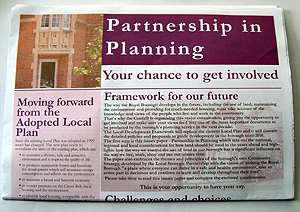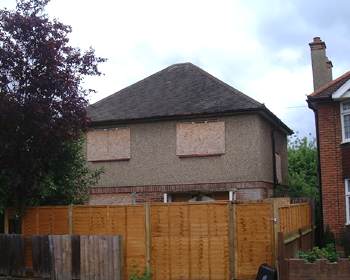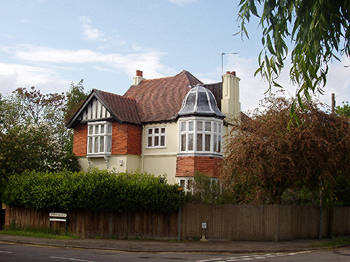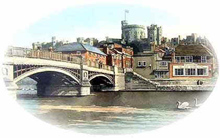Spring 2004
Partnership In
Planning
Major Borough-Wide
Consultation

Introduction
On 23 March 2004 the RBWM published a Press Release entitled Partnership In Planning -
a Major Borough-Wide Consultation and
accompanied it with thousands of newspapers on the subject, delivered
to households throughout the Borough. On this page we cover our
main points and hope that you will take the time to give the
Borough your views.
The Borough has asked for the Response
Form to be with the Directorate of Planning in Maidenhead by
May 24th 2004. The Local Development Framework is intended to
be in place by March 2007. The provisions within the Local Development Framework LDF are intended to be relevant in planning the
town's development up to 2016. it is our view that we must use
this tool to register our opposition to extensive redevelopment
within Windsor and that we believe that Windsor's unique place
in English heritage deserves considerate and specialist treatment.
Future planning decisions revolve around
the Town Plan, renamed
now as the Local Development Framework (LDF) and as such it is
important that our views as residents are made known. For the
purposes of this exercise we are discussing Windsor only. Much
as we wish them well, Maidenhead is a totally different town
and without Windsor's historical significance! We merely share
civic administration. We do not believe that 'sauce for the goose
is also sauce for the gander'.
The Importance of the
Local Development Framework
The revision of the former
Town Plan and its rebirth as the Local Development Framework
(LDF) is an important document for Windsor and any changes or
departures from the existing Town Plan must be carefully considered.
In many respects the provisions in the LDF should be tightened
up along the lines outlined below for it is this document that
our planners should abide by when considering planning applications
within Windsor. It is to be hoped that undesirable applications
can be avoided in the future by stating clearly what is and what
is not desirable in the town.
It should be remembered
that government policy in 2004 is to substantially increase housing
starts in the SE of England. The Office of the Deputy Prime Minister
(ODPM)
say they are looking to give priority to cheaper, "affordable"
housing. This could pose a threat to Windsor in the LDF by permitting
higher density housing than at present. If the revised document
permits 1000s of additional houses to be built in the south-east,
as Deputy Prime Minister John Prescott seems to think is a good
idea, then planning refusals will be very difficult here in Windsor.
In order to protect Windsor
from over-development, the LDF must state clearly what kind of
development is permitted and where it is permitted. In addition,
developers should be able to clearly identify the likelihood
of permissions being granted or denied prior to embarking on
land or property purchase. The Local Development Framework should
discourage developers looking for a profit from increasing the
density on a particular site. The threat to five properties in
Clarence Road is an example of the kind of development that should
be resisted for the simple reason that if it is permitted,
then the entire length of Clarence Road will be at risk. This
is because of the low density of the housing currently along
the road which, with their large gardens, is ideal for the construction
of flats. It is for this reason that the Royal Windsor Website
opposes the destruction of these quality 1930s residential properties
and their replacement by poorly designed, architectural jokes,
as was permitted a few years ago on the other side of the road.
See
Story here.

Cleveland, 2 York
Avenue, Windsor, left empty for several years
One of the dangers of an
unclear development planning strategy is that properties can
be left empty for years at a time, scarring the community, before
a resolution is finally found. An example of this is to be found
at Cleveland, 2 York Avenue, Windsor, where a property has been
left empty since 2001 while the developers seek permission to
demolish the house and construct four town houses. Three years
later, in May 2004, permission continues to be refused on the
grounds of parking limitations, density and access. The application
has been appealed and must now be heard by The Planning Inspectorate
later in the year. We trust that permission will continue to
be be refused as the plans are inappropriate for a small corner
site. The penalty as far as local residents are concerned is
that the eyesore that the boarded up house has become will remian
for a year or two yet. This visual blot should not be permitted.
There are other properties in Windsor that have been similarly
abandoned for extended periods of time, not least Sydney Camm's
house in Alma Road, though this was of the council's own making
where it attempted to push through the construction of a very
large car park in the centre of Windsor. The houses were to be
demolished to make way for the access road!
Our view is simply that
situations such as this can be minimised by clear guidelines
from the outset in the form of The Local Plan and the LDF.
It is the policy of The
Royal Windsor Website to oppose most increases in housing density
in the Royal Borough of Windsor because we believe the town is
a special case. If this is Nimbyism then so be it. Yes, we
are proud to be Nimbies, and with good reason! An example
of inappropriate development is recounted here, where a very attractive detached
older property was threatened in 2003 with demolition to make
way for twenty flats. Previously, back in the late 50s, land
attached to this property was permitted to be built upon, reducing
the garden area by about half.

38 York Road, a
delightful property that had been the subject of a redevelopment
application, but which was refused in December 2003
There are many other examples
of inappropriate planning approvals in the past, not least Ward
Royal, which was a tragic mistake in the town centre. We assume
that mistakes of this calibre and magnitude will not be permitted
again and that the Local Development Framework will provide a
safeguard.
We do not always oppose
development within the town, just in case a reader might think
we are Total Nimbies. We did not oppose the Trevelyan School
redevelopment, although we would have preferred to see two storey
rather than three storey buildings, and we did not oppose the
development in Green Lane adjacent to the Scout Hut as we were
under the impression that a new, modern cub and scout facility
would be built in the place of the older building. Recent developments
in St Leonards Road do not seem to be too intrusive either, such
as the Fiat garage redevelopment, where the demolition of an
old car sales area, Hardings, was replaced by modern apartments.
Public Open Space
In the current Town Plan,
adopted in July 1999, it is shown that Windsor suffers a shortfall
in informal Public Open Space of some 32.42 hectares according
to a 1991 survey included in the Town Plan as Appendix 1. Considering
that the required amount of POS for the given population of 27,395
at that time was 68.49ha, the shortfall amounted to approximately
90%. This is in 1991. This excludes the significant numbers of
new homes built in the last decade throughout the Windsor area
which could well push the population up to around 30,000 and
a target POS provision of 75ha. For the sake of argument Windsor
has half the POS it should have and planning permissions, although
restricted, continue to be granted.
We propose that new developments
in the Windsor area should not be permitted unless ACTUAL Public
Open Space is provided except where the development is too small
to make this practical. This means that the facility whereby
payments can be made to the Borough in lieu of Open Space be
scrapped. There is something rather distasteful about the Borough
making money through a shortfall in its own facilities and provisions.
We understand that this income is said to be spent on play areas,
equipment and the like, but we maintain that it is not a desirable
state of affairs which can lead to the loss of open areas in
return for cash payments.
Conclusion
We hope that we are selective
in our nimbyism which can be summarised as follows:
Planning applications in
Windsor should not permitted in the following locations and circumstances:
- Where existing, 'quality'
houses are threatened with demolition. The term 'quality' is,
we know, contentious and debatable. However, in most cases it
is self-evident if a property has been soundly constructed and
is in harmony with its local surroundings. For the purposes of
planning permissions we believe that most property built in the
inter-war years falls in this category. Similarly we believe
that the extensive areas of Victorian terraced housing and villa
style housing should be protected especially where entire streets
are built in the same style and are of the same era. The Local
Development Framework should also address the problem of inappropriate
external doors, windows and roofing materials on older properties,
regardless of being in a conservation area or not.
- Where privately owned
land, such as gardens, allotments, pastures or public open spaces
would be reduced in area or lost. In the event that allotments
are no longer required, the land should be made available as
Public Open Space and covenanted as such to prevent any future
threats to their existence, except return to use as allotments
if the demand arose.
- Where an increase in density
would adversely affect the required area of Public Open Space
per 1000 population, payments of cash to the Borough in lieu
of Public Open Space provision must be curtailed or halted altogether.
The Royal Borough's Press
Release
The way the Royal Borough
develops in the future will take into account the knowledge and
views of local people through a major consultation to get under
way next week (Monday March 29).
The current local plan,
now up for review, was adopted in 1999. Its replacement
the Local Development Framework - will contain the detailed
policies and proposals to guide development in the borough until
2016.
The first step is a comprehensive
issues paper - Partnership in Planning - which will be used as
the basis for community consultation, encouraging the involvement
of the widest possible range and number of people in helping
to shape the borough of the future.
- The issues paper spells
out the national, regional and local considerations for how land
should be used in the years ahead, including the three key elements
of government guidance:
- sustainable development
and communities, including use of available natural resources
- urban renaissance
creating a high quality environment in all urban areas
- green belt focusing
development away from the countryside.
It also embraces the themes
and principles of the borough's own community strategy and highlights
how land use planning has a significant influence on the way
people live, work, shop and use their leisure time.
Cllr Vicky Howes, lead
member for planning, said the local plan was one of the most
important documents produced by the council and the release of
the issues paper was an exciting step towards a new planning
framework for the future.
She added: "The
Local Development Framework will influence where we can set up
home and do our shopping, where we work, how we travel, the leisure
and education facilities available for us and our families, the
quality of the environment we live in and the preservation of
the countryside for us to enjoy.
"There is hardly an
area of our lives that the local plan doesn't touch so
it is vital that everyone is given the opportunity to be a partner
with the council and have a say in the document which will take
us through the next 13 years. This consultation is the
chance for local people to make their mark and influence the
future of the borough for themselves and their children."
The issues paper, with
its accompanying questionnaire, is being sent to every household
with the spring edition of Around the Royal Borough. Copies
will go to parish councils, employers, voluntary and statutory
organisations, churches, developers and community outlets.
There will also be an exhibition in the Nicholsons Shopping Centre,
Maidenhead, and Windsor Royal Station after the Easter holidays.
This initial public consultation
will last for eight weeks and all comments should be returned
to the special freepost address: Directorate of Planning
and Environment, RB OF Windsor and Maidenhead, FREEPOST (SCE1944),
MAIDENHEAD, Berkshire SL6 1GZ, no later than May 24.
Note: The government has set a target
date of March 2007 for all local authorities to have their Local
Development Framework (the new-style local plan) in place.
The Royal Borough's framework timetable and the results of the
issues paper consultation will go to cabinet later this year.
Filling in the Response
Form
The simple rule when filling in this form
is to only tick those boxes that do not require new buildings
or other expansion in the town centre or immediate surroundings.
For example, Question One asks where you think development should
take place. Care is needed here. The choices are:
Option One: Within the town centre.
We say: No right thinking
resident is going to want to see the centre of Windsor demolished
to make way for higher density building, so that is out.
Option Two: Within smaller centres excluded
from the Green Belt.
We say: It is unlikely
that there are any areas around Windsor where that option would
be acceptable and probably falls under Option Five below.
Option Three offers the option to build
within the Green Belt
We say: This is totally
unacceptable. The Green Belt must be protected at all costs throughout
the UK.
Option Four suggests development along
transport routes adjacent to railway stations and bus routes.
We say: 'Ribbon development'
was popular in the 1930s where homes were built along existing
main roads. This concept was discredited many years ago and as
there is little or no space adjacent to the two stations in Windsor
the option must be a discarded. Building along bus routes would
be as disastrous to the landscape as the ribbon devlopment of
the 1930s proved to be.
Option Five suggests development 'on small
sites within the Borough'.
We say: This is known as
'infilling' and was outlawed to prevent development on divided
garden plots and should be opposed. Planning permission is rarely
given for a large garden to be divided and sold off for development
and rightly so. It has happened in the past, but it is no longer
acceptable in this day and age.
The threatened Clarence Road development could be
described as being 'on a small site' and this option has been
argued against above as being an unaccptable threat to existing
characterful and mature areas. Remember that lots of 'small sites'
eventually join up to be one large site!
Option Six invites you to list 'other locations'.
We say: As we are attempting
to restrict development within Windsor, there is no need to drop
hints or give clues to planners as to where would be appropriate!
Nowhere is appropriate! Well, there are one or two places, but
the developers know only too well where these are so we don't
need to encourage them. We suggest that the only remotely
effective answer to Question One is therefore to state clearly
on Option Six that you do not wish any development to take place
within Windsor.
Now Maidenhead... that
is another bucket of bricks altogether....
Option Seven is don't know.
But we all know you do!
We regret that we have
been unable to cover the Response Form thoroughly but hope to
keep an eye on things in the coming months. Don't forget the
forum to put your point of view. The
Windsor Forum
Local Matters
Index
Royal
Windsor Web Site Home Page

To contact
us, email Thamesweb.
|

